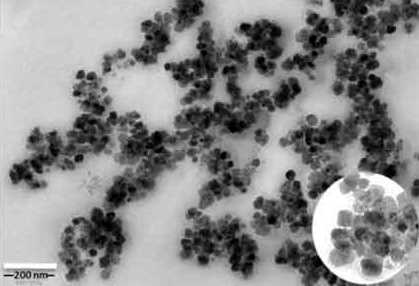The researchers have developed biomimetic magnetic nanoparticles (BMNPs) using MamC, a protein from the magnetotactic bacteria Magnetococcus marinus. The production method they have developed uses green technology, is time- and cost- efficient as well as scalable. Not only avoids the generation of by-products, the use of toxic agents or extreme physical conditions, but also, produces biocompatible superparamagnetic single magnetic domain BMNPs of ~40 nm with novel surface properties that, also, behave as hyperthermia agents. Being superparamagnetic, BMNPs behave as if they were non-magnetic in the absence of an external magnetic field, preventing agglomeration. Having a large magnetic moment per particle, BMNPs respond efficiently when an external magnetic field is applied, allowing magnetic guidance/concentration at the target.
What’s more, this approach avoids additional coating steps for the nanoparticles, as it is required for commercial ones. For BMNPs this step is not necessary, as part of MamC stays bound to the nanoparticle, acting as a link between BMNPs and the component to be carried.
Although these properties make BMNPs a very useful tool for numerous applications, the technology is very promising for clinical applications, particularly for the treatment of cancer and/or localized infections. They have been proven to be effective nanoplatforms that allow the combination of directed chemotherapy and hyperthermia, both on their own and encapsulated in liposomes (magnetoliposomes) in comparison to current nanoparticles and can be further directed by the addition of targeting molecules such as antibodies.
Benefits
These BMNPs provide many advantages in comparison to current commercial magnetic nanoparticles:
1 – The biomimetic approach ensures eco-friendly technologies for the nanoparticle productions and enables the easy scalability of the process.
2 – The nanoparticles are superparamagnetic, single magnetic domain and have large magnetic moment per particle, preventing agglomeration and producing a more effective response when an external magnetic field is applied. In clinical applications, this is of great interest since clots are not expected and allow the jump from systemic to local treatments, with less secondary effects.
3 – The BMNPs have natural functional groups at the surface that allow functionalization with the relevant molecule. It also prevents the extra coating steps, reducing production time and costs. They are naturally charged at physiological pH (allowing the molecule to remain attached in blood), and they naturally become uncharged at acidic (tumoral) pH values, allowing drug release. This release at the target is controlled by naturally occurring environmental pH changes and can be increased by hyperthermia.
4 – BMNPs are biocompatible hyperthermia agents (magnetic hyperthermia and photothermia) allowing directed therapy combination.

